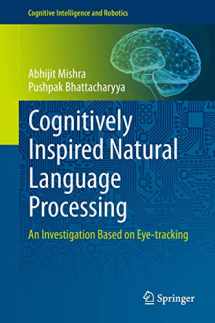
Cognitively Inspired Natural Language Processing: An Investigation Based on Eye-tracking (Cognitive Intelligence and Robotics)
ISBN-13:
9789811315152
ISBN-10:
9811315159
Edition:
1st ed. 2018
Author:
Pushpak Bhattacharyya, Abhijit Mishra
Publication date:
2018
Publisher:
Springer
Format:
Hardcover
191 pages
FREE US shipping
Rent
35 days
Due Jun 12, 2024
35 days
from $79.63
USD
Book details
ISBN-13:
9789811315152
ISBN-10:
9811315159
Edition:
1st ed. 2018
Author:
Pushpak Bhattacharyya, Abhijit Mishra
Publication date:
2018
Publisher:
Springer
Format:
Hardcover
191 pages
Summary
Cognitively Inspired Natural Language Processing: An Investigation Based on Eye-tracking (Cognitive Intelligence and Robotics) (ISBN-13: 9789811315152 and ISBN-10: 9811315159), written by authors
Pushpak Bhattacharyya, Abhijit Mishra, was published by Springer in 2018.
With an overall rating of 3.7 stars, it's a notable title among other
AI & Machine Learning
(Speech & Audio Processing, Digital Audio, Video & Photography , Linguistics, Words, Language & Grammar , Computer Science) books. You can easily purchase or rent Cognitively Inspired Natural Language Processing: An Investigation Based on Eye-tracking (Cognitive Intelligence and Robotics) (Hardcover) from BooksRun,
along with many other new and used
AI & Machine Learning
books
and textbooks.
And, if you're looking to sell your copy, our current buyback offer is $0.3.
Description
This book shows ways of augmenting the capabilities of Natural Language Processing (NLP) systems by means of cognitive-mode language processing. The authors employ eye-tracking technology to record and analyze shallow cognitive information in the form of gaze patterns of readers/annotators who perform language processing tasks. The insights gained from such measures are subsequently translated into systems that help us (1) assess the actual cognitive load in text annotation, with resulting increase in human text-annotation efficiency, and (2) extract cognitive features that, when added to traditional features, can improve the accuracy of text classifiers. In sum, the authors’ work successfully demonstrates that cognitive information gleaned from human eye-movement data can benefit modern NLP. Currently available Natural Language Processing (NLP) systems are weak AI systems: they seek to capture the functionality of human language processing, without worrying about how this processing is realized in human beings’ hardware. In other words, these systems are oblivious to the actual cognitive processes involved in human language processing. This ignorance, however, is NOT bliss! The accuracy figures of all non-toy NLP systems saturate beyond a certain point, making it abundantly clear that “something different should be done.”


We would LOVE it if you could help us and other readers by reviewing the book
Book review

Congratulations! We have received your book review.
{user}
{createdAt}
by {truncated_author}


